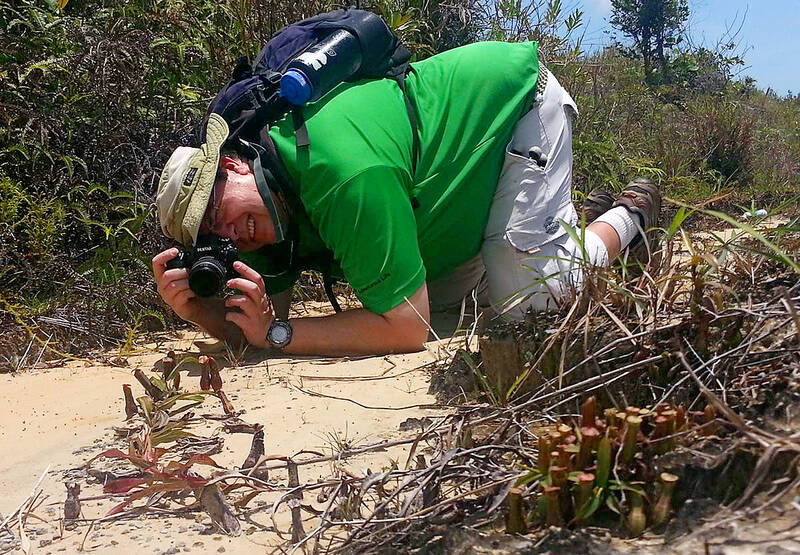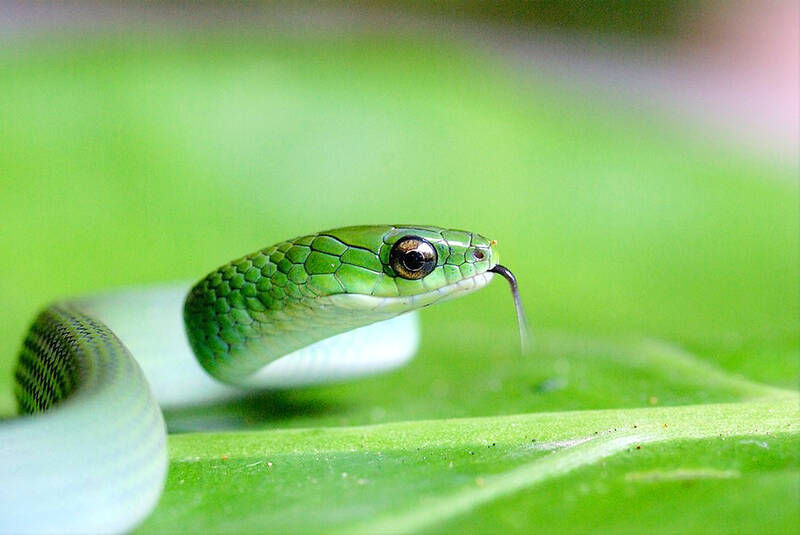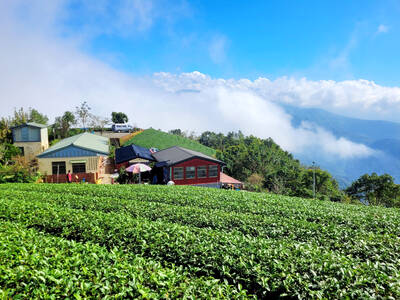Some people will never forget their first meeting with Hans Breuer, because it occurred late at night on a remote mountain road, when they noticed — to quote one of them — a large German man, “down in a concrete ditch, kicking up leaves and glancing around with a curious intensity.”
This writer’s first contact with the Dusseldorf native was entirely conventional, yet it led to a friendly correspondence that lasted until Breuer’s death in Taipei on Dec. 10. I’d been told he’d be an excellent person to talk to for an article I was putting together, so I telephoned him, and we chatted about the hobby known as herping.
He made a compelling case, explaining why nature lovers in Taiwan should go out after dark to find reptiles and amphibians in their natural habitats, and how they could do it. The conversation ended with Breuer inviting me to meet up with him and his family in Malaysia.

Photo courtesy of the Breuer family
PASSION FOR WILDLIFE
Countless individuals, among them local schoolchildren and Western expatriates, found Breuer’s passion for snakes and other wildlife infectious.
By answering strangers’ questions via www.snakesoftaiwan.com (a Web site Breuer curated with Bill Murphy, an American living in Taoyuan), visiting elementary schools to explain the role of snakes in forest ecosystems, and engaging with hikers, cyclists and others he encountered while searching Yangmingshan National Park or the North Cross-Island Highway for legless reptiles, Breuer educated thousands about the diversity of Taiwan’s snake population. Convincing those he met that these creatures should be treasured rather than feared was very much part of his mission.

Photo courtesy of the Breuer family
When taking deep-dives into local nature, things didn’t always go to plan. Dave Johnson recalls one such occasion.
“Visibly and audibly pleased with himself on discovering and promptly grabbing a particularly well-concealed snake from a ditch, Hans turned and proceeded to step on the head of a rather obvious serpent slithering across the road, causing its immediate demise!”
Johnson, a British businessman who divides his time between Taipei and Taitung, recalls his German friend as “a genuine storybook of a person.”

Photo courtesy of the Breuer family
Breuer first arrived in Taiwan in 1989, having studied Sinology at Ruhr-Universitat Bochum. Various translation and interpretation jobs followed. He once told this writer that an early client was an old-school German businessman who often visited his suppliers in Taiwan, but spoke neither English nor Chinese, and who insisted on eating every meal at McDonalds.
Later, he established a company that offered language localization services to the computer game industry. This allowed him to work from home — and in 2011 to relocate with his wife and two sons to Kuching in the Malaysian state of Sarawak. He said he had two main motives for moving away from New Taipei City’s Sanjhih District (三芝): He wanted his children to attend an international school in Kuching, and he hoped to explore Borneo’s fabulous ecosystems.
The eight-year sojourn was successful on both counts. The family thrived, and Breuer’s adventures in the jungles and national parks of Sarawak inspired his second book, A Greenhorn Naturalist in Borneo (2022). His first, titled A Cobra Hijacked My Camera Bag! Snakes and Stories from Taiwan, was published in 2012.
GOURMAND
In addition to being a herper and a birder, Breuer was a gourmand. Over the course of two visits, in 2017 and 2019, he introduced this writer’s family to some of Kuching’s finest eateries, and explained why Sarawak laksa (a spicy noodle dish) was one of humanity’s greatest inventions. Everyone who knew him knew he also adored durians.
After the family moved back to Taiwan, his social media feed featured more recipes than snakes, prompting him to post: “What has become, alas! Of the great python hunter? Spending all Sundays now cooking. Not chasing the Lindwurm. Is it old age?”
Breuer leaves behind innumerable friends, wife Lisa Liang (梁素芬), and sons Hans Jr and Karl. Hans Jr works in sales for an online tuition center. Karl is in his last year at National Taiwan University of Arts (NTUA), where he’s a mainstay of the NTUA Sharks basketball team.

In recent weeks the Trump Administration has been demanding that Taiwan transfer half of its chip manufacturing to the US. In an interview with NewsNation, US Secretary of Commerce Howard Lutnick said that the US would need 50 percent of domestic chip production to protect Taiwan. He stated, discussing Taiwan’s chip production: “My argument to them was, well, if you have 95 percent, how am I gonna get it to protect you? You’re going to put it on a plane? You’re going to put it on a boat?” The stench of the Trump Administration’s mafia-style notions of “protection” was strong

Every now and then, it’s nice to just point somewhere on a map and head out with no plan. In Taiwan, where convenience reigns, food options are plentiful and people are generally friendly and helpful, this type of trip is that much easier to pull off. One day last November, a spur-of-the-moment day hike in the hills of Chiayi County turned into a surprisingly memorable experience that impressed on me once again how fortunate we all are to call this island home. The scenery I walked through that day — a mix of forest and farms reaching up into the clouds

With one week left until election day, the drama is high in the race for the Chinese Nationalist Party (KMT) chair. The race is still potentially wide open between the three frontrunners. The most accurate poll is done by Apollo Survey & Research Co (艾普羅民調公司), which was conducted a week and a half ago with two-thirds of the respondents party members, who are the only ones eligible to vote. For details on the candidates, check the Oct. 4 edition of this column, “A look at the KMT chair candidates” on page 12. The popular frontrunner was 56-year-old Cheng Li-wun (鄭麗文)

Oct. 13 to Oct. 19 When ordered to resign from her teaching position in June 1928 due to her husband’s anti-colonial activities, Lin Shih-hao (林氏好) refused to back down. The next day, she still showed up at Tainan Second Preschool, where she was warned that she would be fired if she didn’t comply. Lin continued to ignore the orders and was eventually let go without severance — even losing her pay for that month. Rather than despairing, she found a non-government job and even joined her husband Lu Ping-ting’s (盧丙丁) non-violent resistance and labor rights movements. When the government’s 1931 crackdown